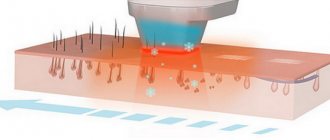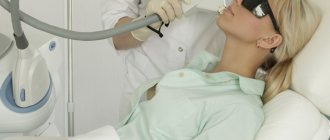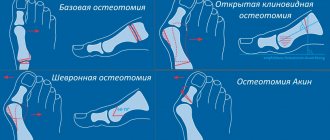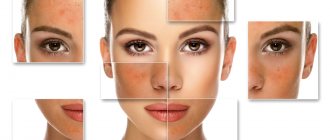15.04.2017
Onychomycosis is a fungal infectious disease that affects the fingernails and toenails. According to statistics, nail fungus is diagnosed in 20% of the population.
You can become infected in public places - in a bathhouse, sauna, swimming pool. Favorable conditions for the development of fungus are warmth and dampness.
Among the signs of the disease are:
- changes in the color, thickness and shape of the nail;
- the presence of yellow or dark stripes, spots on the nails;
- unpleasant smell of rot;
- peeling of the skin around the affected nails;
- the nail peels, crumbles, breaks.
The symptoms themselves are not dangerous, so many people do not consider it necessary to treat nail fungus, believing that everything will go away on its own. However, the disease must be treated because it is very contagious, makes the body susceptible to viruses and bacteria, and is fraught with complications. Fungal onychomycosis should be treated as early as possible.
After the doctor confirms the suspicions and makes a diagnosis, suitable medications and procedures will be prescribed to treat nail fungus. In very advanced stages, the nail will have to be removed.
Typically, removal is prescribed when the fungus has penetrated deep into the tissue and the medications cannot act through the nail plate. Medicines can be prescribed internally and externally. But sometimes treatment takes too long, then laser therapy is a more effective option.
For the procedure, different types of laser can be used, which differ in action and wavelength:
- erbium;
- neodymium;
- diode
Erbium laser for fungus
The erbium laser successfully breaks the stereotypes that laser treatment of nail fungus is a painful and unpleasant procedure. The erbium laser acts ablatively and thermally on the tissue of the nail plate, vaporizing the nail layer by layer.
There are no burns from such a laser; for its peculiarity, this method is even called a “cold” beam. The essence of the method is to remove the vessels that feed the mycelium.
The erbium beam carefully treats the nail plate, the work is carried out very precisely, including hard-to-reach places. To completely cure nail fungus, it is enough to undergo about 6 procedures.
Possible complications after laser therapy
Treatment of fungal infection of the nail plate with a laser is a fairly safe procedure. There can be one reason for the complication - the lack of professionalism of the doctor who conducted the session. Therefore, it is very important to seek help only from trusted medical institutions with experienced specialists and where reliable equipment is used.
Problems arise when the doctor has little experience
If you do not comply with all operating conditions on the equipment, this can lead to the following complications:
- burn of the skin around the nail;
- infection;
- deformation of the nail plate.
When the procedure is performed in a professional, reliable facility, it is unlikely that any side effects will occur. There, treatment is carried out using certified equipment and experienced specialists work.
Attention! Medical centers usually use lasers, which do not heat tissue. Therefore, procedures cannot cause tissue burns.
It's better to trust a specialist
Neodymium laser
It is considered the most popular procedure. The essence of the treatment is to heat the affected nail plate to 43-52 degrees, without injuring the skin.
The procedure is practically painless, there is no blood. Neodymium laser treatment for nail fungus is considered optimal among the 3 procedures due to its wavelength.
It is this that allows the beam to penetrate deep into the structure of the nail, destroying the mycelium. The heat emitted by the laser has an additional antibacterial and healing effect, cells regenerate faster. To completely undergo laser treatment for fungus, you need about 7 procedures.
Description and essence of the method
A laser is a source of specific electromagnetic waves coming in the form of ultra-thin beams. Thanks to their special structure, waves are able to penetrate any obstacle and destroy the desired target at any depth. Therefore, the laser is able to cope with nail fungus, even if the mycelium lies in deep layers - up to 7 mm.
The laser beam burns out the body of the parasitic mycelium completely, so this method of treatment is radical and extremely effective.
You may also be interested in information about whether laser resurfacing or chemical peeling is better.
The standard course of treatment lasts from a month to a month and a half, and includes, on average, 3-4 laser sessions. Sometimes less or more depending on the severity of the lesion. Sessions are not conducted daily: after each session, a period of time of at least a week is required so that the tissues have time to recover.
Video shows laser treatment for nail fungus:
We note the safety and harmlessness of this procedure. In addition, laser treatment is completely painless, which is also important.
It will also be useful for you to learn about what electrolysis or laser hair removal looks like and how it is performed.
Diode laser treatment
This type of laser against nail fungus has been used for a long time. The essence of the method is the temperature effect on the nails. During the procedure, tissues affected by the fungus evaporate, while healthy ones are not affected.
At high blood temperatures, the procedure may be accompanied by a slight burning sensation and tingling sensation. Some doctors consider the technique outdated, arguing that treatment of onychomycosis with an erbium-type laser is faster. However, the price of a diode will be cheaper.
How many procedures will be needed to get rid of the fungus depends on the location of the fungi and the degree of damage to the nail. In general, even with advanced nail fungus, treatment will take no more than 10 procedures. During treatment, the nail plate is removed, and a new nail will grow in a few months.
Types of nail fungus
In dermatology, toenail fungus is divided into three types, each of which has characteristic symptoms and is accompanied by certain changes on the nail plate.
- Normotrophic type is the initial form of the fungus, in which yellow stripes and spots appear on the edges of the nail. At this stage, the nail plate does not lose its shine and does not change thickness.
- Hypertrophic form - characterized by pronounced thickening and deformation of the nail, which loses its shine, becomes rough, and loses its aesthetic appearance. Lack of treatment can lead to the development of onychogryphosis, when the nail takes on the appearance of a bird's claw.
- Atrophic onychomycosis - at this stage the nail separates from the nail bed, becomes dull, and becomes gray-brown in color. The skin at this stage of the disease is covered with loose hyperkeratotic layers.
Be careful when choosing a laser
Among the offers of various clinics, you can also find those that offer treatment of nail fungus with a low-intensity laser. If, in addition, the advertisement says that after such a procedure patients recover completely, this is a deception. Low-level laser can only eliminate symptoms.
More precisely, the procedure will help improve tissue metabolism and start the process of nail regeneration. Therefore, to the question - is it possible to cure fungus with a low-intensity laser - we can confidently say that it is not possible - after a while the fungus will return.
Compared to the use of medications and surgical treatment, laser procedures are safer and have no side effects. Therefore, laser treatment of nail fungus can be prescribed to older people and children. The following reasons may be contraindications:
- diabetes mellitus, epilepsy, oncology;
- pregnancy and breastfeeding;
- the presence of infectious, viral, chronic diseases in the acute stage;
- visiting a solarium less than 14 days before the procedure;
- taking anticoagulants, immunosuppressants, etc.
Benefits of laser treatment
Every doctor recognizes fungal treatment with laser as the most optimal. This method of eliminating fungal infections has proven to be the most effective and safe. Proof of this are numerous positive reviews and attractive advantages:
- safe procedure (the laser acts only on infected areas, leaving healthy areas untouched);
- comfort (there is no need to take a course of medications for many months and apply ointments that do not guarantee a positive effect);
- painless treatment (no pain);
- no anesthesia (minimal effect on the body);
- complete relief from the problem;
- results after the first time of the procedure;
- the procedure takes 20-30 minutes.
Advantages and disadvantages of laser in the treatment of nail fungus
Like any treatment method, laser has its pros and cons. There are many more positive aspects. This includes the vastness of the technique, which minimizes the risk of infection.
The painlessness of the procedure is also of great importance. Unlike mechanical nail removal, anesthesia is not needed, which means there will be no allergic reaction and a long rehabilitation period.
An important advantage of the laser is the absence of side effects on internal organs, as is the case with systemic drugs that destroy the liver, kidneys, etc.
As for the effectiveness of the laser, 96% of patients experience improvements after 2–3 procedures, 95% of patients are cured of the fungus within six months, and 3% forget about the fungus after additional procedures. The speed of the procedure cannot be ignored - one session will take less than half an hour.
As for the disadvantages of laser therapy, for the most part they are observed if the treatment is carried out by an incompetent doctor. Then burns on the skin are possible, and the infection can spread to healthy nails.
If treated incorrectly, the nail plate becomes deformed, scars and cicatrices appear, and nail growth stops. This is why it is so important to contact an experienced doctor rather than choosing the lowest cost procedures.
Treatment of nail fungus with laser
Procedures for eliminating foci of fungal infection can be carried out using several types of laser systems, which differ in the principle of their effect on pathogenic microorganisms. Thus, if one type of installation is capable of eliminating the mycelium of pathogenic pathogens by increasing the temperature of the internal structures of the nail plate, then another type of device from a cold laser discharge solders small vessels from which nutrients for microorganisms are supplied, due to which they die without proper nutrition . When carrying out laser therapy, the sequence of actions performed is observed:
- Protective glasses are put on the patient's visual organs from exposure to laser beams;
- a specialized varnish is applied to the prepared areas infected with the pathogen, which enhances the effectiveness of laser radiation;
- The next step is treatment with a laser beam with an intensity selected depending on the degree of infection of the nail plate.
In advanced cases, when treatment becomes impractical due to its unproductiveness, it is possible to use a laser to remove the damaged nail plate itself. In such cases, a hemostatic tourniquet is applied to the anesthetized finger, after which the nail is removed layer by layer. Upon completion of the procedure, any remaining soft tissue is removed from the nail bed.
Purchasing a laser device on your own is possible, but using it to treat fungal infections without specialized skills can lead to extremely negative consequences for the body.
Preparing for laser nail treatment
Before making an appointment for laser nail removal, you need to be examined by a dermatologist and be tested for the pathogen and its sensitivity to antifungal drugs. Before the test, you need to stop taking medications about a week, remove nail polish 2 days before the procedure, and do not cut your nails the day before the test.
It is also worth preparing for the laser procedure - the evening before the procedure, you need to steam your leg for 20 minutes in a basin where 5 liters of hot water are mixed with 1 tbsp. soda and 50 g of grated laundry soap.
After this, the nails are cut short and treated with a file (the tools are disinfected or disposable ones are used). On the day of the procedure, the nails are not treated with anything. Laser therapy is carried out in sessions with breaks of 1-2 weeks. The entire course of treatment may take about six months.
During treatment, doctors recommend wearing loose shoes, changing socks regularly (if you have fungus on your toenails), and keeping your extremities dry. Nail care should be carried out only with tools that are well disinfected.
Complications
If the treatment method is violated or any conditions are not met, a person may experience the following consequences:
- changing the shape of the nail;
- burns on the cuticle and skin;
- small scars;
- the disease gets worse.
All of these complications usually occur after procedures performed by a specialist with insufficient qualifications and experience. Therefore, to protect against unpleasant moments, it is recommended to contact a specialized medical institution, where they will provide appropriate assistance.
Contraindications
Like any method, laser intervention has contraindications:
- acute inflammatory processes;
- oncological diseases;
- infections of viral etiology;
- diabetes;
- bearing a child and lactation period;
- streptoderma;
- connective tissue diseases;
- incompatibility with taking other medications;
- disorders of the immune system and use of immunomodulators;
- epilepsy;
- psychoemotional disorders.
Also prohibited for starting treatment are peeling and visiting a solarium. You need to wait a couple of weeks before starting laser treatment for mycosis.
It should also be noted that the laser is not used immediately after surgical removal of internal organs. Treatment can only be carried out after complete recovery.
Efficiency of the method
Laser therapy for nail fungus is an effective method of combating the disease, which has a number of undoubted advantages:
- simplicity of the procedure;
- efficiency and safety;
- short treatment period;
- keeping surrounding tissues healthy;
- complete painlessness;
- lasting results;
- no side effects;
- no need for rehabilitation.
The cost of the procedure is completely affordable for patients; there are many clinics where you can sign up for laser treatment.











